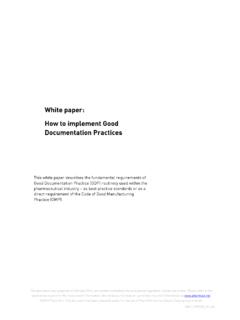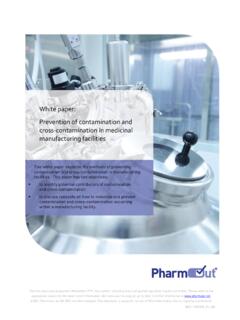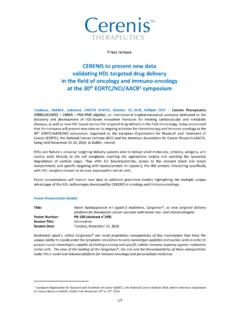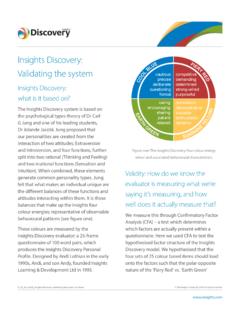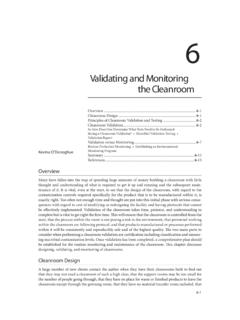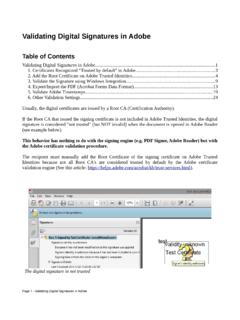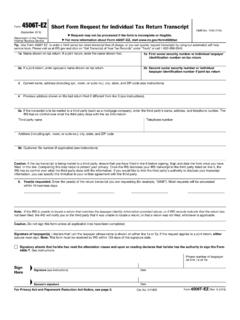Transcription of Top 10 considerations when validating an autoclave - …
1 This document was prepared in February 2016, any content including links and quoted regulation may be out of date. Please refer to the appropriate source for the most recent information. We endeavour to keep an up-to-date record of information at 2016 PharmOut. This document has been prepared solely for the use of PharmOut and its clients. Copying is prohibited. MKT_TMP200_01_r06 White paper: Top 10 considerations when validating an autoclave validating an autoclave is a daunting and time-consuming task. This white paper details the tricks, tips and traps to such a validation project from how to choose your control to which load configuration to use for your validation runs.
2 PharmOut white paper: Top 10 considerations when validating an autoclave PharmOut Pty Ltd, ABN: 85 117 673 766, Unit 10, 24 Lakeside Drive, Burwood East, Victoria 3151. Ph: +61 3 9887 6412, Fax: +61 3 8610 0169, Email: Web: 2016 PharmOut. This document has been prepared solely for the use of PharmOut and its clients. Copying is prohibited. Page 2 of 14 MKT_TMP200_01_r06 Consideration 1 Choosing the right sterilisation cycle to implement There are three basic types of sterilisation cycles. Choose the right one according to the type of goods to be sterilised: Hard Goods (Vacuum) Suitable for items that are easy to sterilise, because air removal and steam penetration are highly effective on these items , open glassware and large diameter piping.
3 A typical hard goods cycle may draw one vacuum prior to introducing steam to reach the desired sterilisation temperature. Wrapped Goods (Vacuum) Utilized for items that are difficult to sterilise, because air removal and steam penetration are harder to achieve on these items than on hard goods , empty bottles (glass or plastic) with lids, gowns, long hoses/tubes, vent filters, portable vessels with small inlet/outlet ports. A typical wrapped goods cycle may draw three or more vacuums prior to reaching sterilisation. A post-sterilisation vacuum draws the steam from the load items. Liquids (Non-vacuum) Items that contain liquids generally cannot have a deep vacuum pulled or the liquid will be drawn out of them.
4 autoclave cycles for liquids generally heat up and cool down without a vacuum. Steam, introduced into the top of the chamber, displaces the air. The air is pushed to the bottom of the chamber and is removed. PharmOut white paper: Top 10 considerations when validating an autoclave PharmOut Pty Ltd, ABN: 85 117 673 766, Unit 10, 24 Lakeside Drive, Burwood East, Victoria 3151. Ph: +61 3 9887 6412, Fax: +61 3 8610 0169, Email: Web: 2016 PharmOut. This document has been prepared solely for the use of PharmOut and its clients. Copying is prohibited. Page 3 of 14 MKT_TMP200_01_r06 The steps involved in choosing the right sterilisation cycle: Is the cycle time-dependent?
5 Minimum requirement is an SAL of 10-6. Is an OVERKILL cycle required? In an OVERKILL approach you avoid collecting bioburden and D-value data by assuming worst-case conditions. A bioburden of 106 of a highly heat-resistant spore-forming bacteria (Bacillus stearothermophillus) is utilized. The D-value at C for these bacteria is generally to 2 minutes. Therefore, using 2 minutes is a good worst-case ideal conditions, an OVERKILL sterilization cycle at C is thus 12 log x 2 min/log = 24 minutes For items that are more difficult to sterilize (eg. some Wrapped Goods such as empty bottles with lids) it will be necessary to increase the time to 40-45 minutes to achieve a min SAL of 10-6 and equilibrium at C: +2 C/-1 C for at least 21 minutes.
6 NoYesA lower SET temp means a longer sterilization time (ideal for temperature sensitive items) and a higher SET temp means a shorter sterilization time and a faster cycle (ideal for Hard goods).NoYesFactors not taken into account here but should be considered are as follows (usually in consultation with the autoclave manufacturer): the number of pre vacuums requiredthe amount of post vacuum drying cycles neededwhether the items being sterilized can withstand the vacuum(s)Note: Some pharmaceutical companies divide cycles into two types; porous (Hard goods, Wrapped goods) and liquids ( non-porous).
7 Determine the SET temperature (usually C)The cycle is determined by TIME at C and is controlled via the DrainDecide which liquid CONTROL to use and ensure ongoing consistency with the amount of liquid present during the validation runs and all subsequent processing cycle is controlled via a liquid CONTROL and the sterilization time is determined by the accumulated F0 of the CONTROL. This is ideal for heat-sensitive samplesUsually need F0 > 15. However, to achieve a minimum SAL (at the end of the cycle) 10-6 you need to incdrease the F0 to 20 (to be certain you get F0 > 15 at all points in the load)Min.
8 6 log reduction required and SAL of 10-6 Assume worst-case conditions, 12 log reduction and a min SAL of 10-6An ideal sterilization cycle can be determined with three variables: bioburden, D-value and required SAL. With prior knowledge of the bioburden and D-value you can determine the ideal cycle TIME for a min. SAL of 10-6: eg. Bioburden = 100 and D= min/log then:Log (Bioburden) = Log (100) = 2 Log Reduction = 2 log + 6 log = 8 log, and Ideal Cycle TIME = Log Reduction x D = 8 log x min/log = 12 minutesTo achieve a minimum 6 log reduction temperatures need to be at C for 15 minutes.
9 Therefore, setting a time of 20 minutes at C should meet criteria. PharmOut white paper: Top 10 considerations when validating an autoclave PharmOut Pty Ltd, ABN: 85 117 673 766, Unit 10, 24 Lakeside Drive, Burwood East, Victoria 3151. Ph: +61 3 9887 6412, Fax: +61 3 8610 0169, Email: Web: 2016 PharmOut. This document has been prepared solely for the use of PharmOut and its clients. Copying is prohibited. Page 4 of 14 MKT_TMP200_01_r06 Consideration 2 Which load configurations to use? A variable to consider is whether to use fixed load or variable load configurations.
10 There s a trade-off here between validation effort and operational flexibility do you want to validate a wide range of load configurations to increase Production s flexibility in loading the autoclave ? Here are some typical load configurations to consider: A fixed load/fixed position configuration means that any load to be sterilised will be placed inside the chamber in exactly the same way for every processing run. A diagram of the load configuration should appear in the Standard Operating Procedure (SOP) so that operators can reproduce the load for every processing run. This situation requires the fewest validation runs (3), but offers no flexibility in load configurations.



